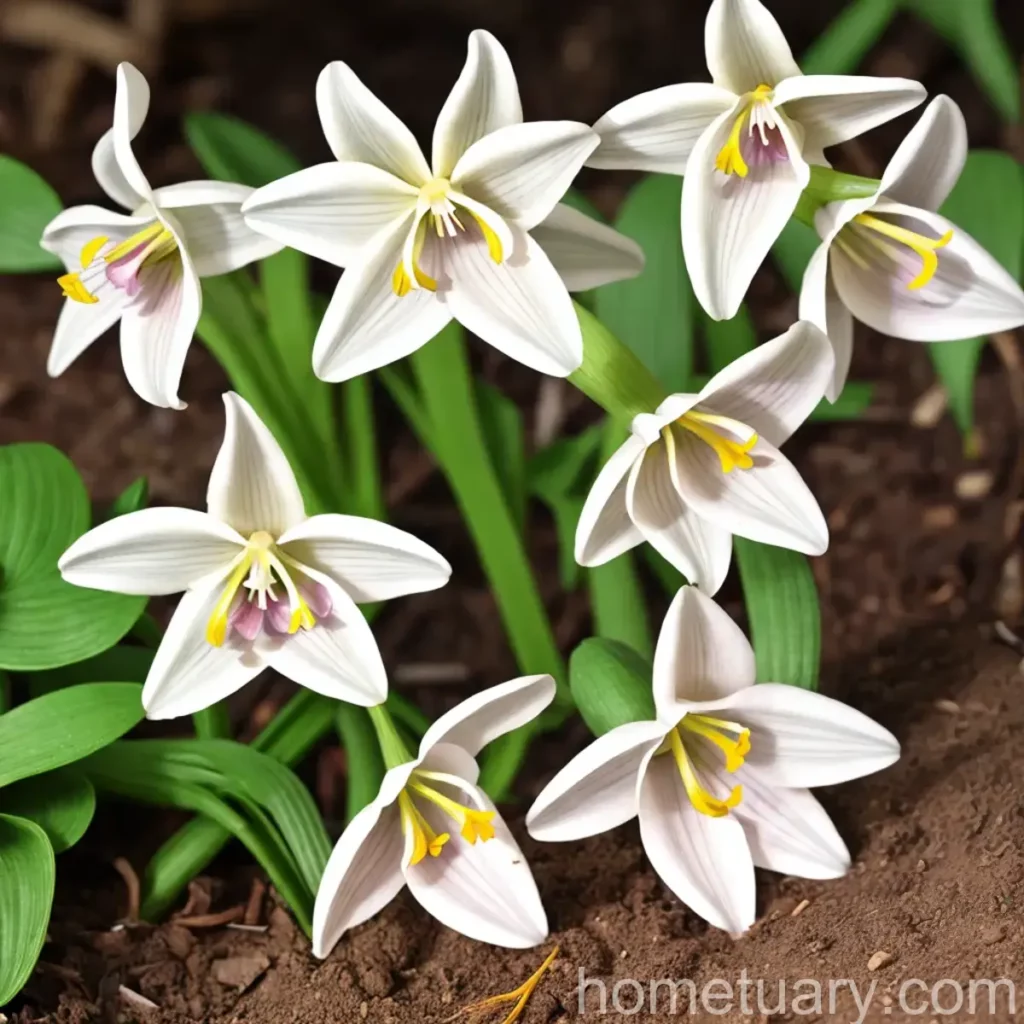White Dog’s-tooth Violet (Erythronium albidum): A Comprehensive Guide
White dog’s-tooth violet, scientifically known as Erythronium albidum, is a stunning perennial plant known for its delicate, white, lily-like flowers. This plant, native to North America, particularly the eastern United States, is a beloved addition to woodland gardens and naturalized areas. In this comprehensive guide, we will delve into the key aspects of the white dog’s-tooth violet, including its culture, uses, water and sunlight requirements, fertilizer needs, soil preferences, pruning tips, propagation methods, container gardening, common diseases and pests, and some fascinating fun facts. So, whether you are a gardening enthusiast, a botany student, or simply an admirer of nature’s beauty, join me in exploring the captivating world of Erythronium albidum.
What is White Dog’s-tooth Violet (Erythronium albidum)?
White dog’s-tooth violet, also known as the white trout lily, white fawn lily, or dogtooth lily, is a herbaceous perennial plant belonging to the Liliaceae family. This species is characterized by its basal, mottled leaves and elegant, nodding, white flowers with yellow centers. The plant typically blooms in the early spring, adding a touch of ethereal beauty to woodland settings.
Key Takeaways – White Dog’s-tooth Violet (Erythronium albidum)
Before we delve into the detailed aspects of white dog’s-tooth violet, let’s summarize the key takeaways about this enchanting plant:
- Scientific Name: Erythronium albidum
- Common Names: White trout lily, white fawn lily, dogtooth lily
- Flower Color: White with yellow centers
- Blooming Season: Early spring
- Native Habitat: Eastern United States
- Plant Type: Herbaceous perennial
Now, let’s explore the various facets of white dog’s-tooth violet, from its cultural preferences to its uses in garden settings and beyond.
Culture
Cultivating white dog’s-tooth violet successfully entails understanding its specific cultural requirements, including its preferred growing conditions, soil preferences, and sunlight and water needs.
Uses
White dog’s-tooth violet serves several purposes in both natural and cultivated settings, making it a valuable addition to gardens and natural landscapes. Some of its uses include:
- Ornamental purposes: The charming white flowers of Erythronium albidum make it a popular choice for adding a touch of elegance to woodland gardens, shaded borders, and native plant landscapes.
- Woodland restoration: In its native habitats, white dog’s-tooth violet plays a crucial role in the restoration and preservation of native woodland ecosystems, contributing to biodiversity and ecosystem health.
Now, let’s delve into the specific cultural requirements for growing and caring for white dog’s-tooth violet.
Water
White dog’s-tooth violet thrives in moist, well-draining soils, particularly in woodland settings where it benefits from the natural moisture and organic matter present in the soil. When cultivated in garden settings, it is essential to provide consistent moisture, especially during the growing season and the flowering period. However, it is equally important to avoid waterlogging, as excessive moisture can lead to root rot and other detrimental conditions.
Sunlight
As a woodland plant, white dog’s-tooth violet thrives in partially shaded to fully shaded locations. When grown in garden settings, it is best suited for areas with dappled sunlight or spots that receive moderate to full shade. While it can tolerate some morning sun, it generally prefers cool, shaded environments, akin to its natural woodland habitats.
Fertilizer
When it comes to fertilizing white dog’s-tooth violet, it is essential to opt for a gentle, balanced fertilizer. A slow-release, organic fertilizer formulated for woodland plants can provide the necessary nutrients for healthy growth and flowering without risking the potential for fertilizer burn or excessive stimulation. Applying the fertilizer in early spring as new growth emerges can support the plant’s growth and development throughout the growing season.
Soil
White dog’s-tooth violet thrives in rich, humus-rich soils with good drainage. Woodland soils with ample organic matter and a slightly acidic to neutral pH are ideal for this species. When cultivating it in garden settings, amending the soil with organic matter such as compost, leaf mold, or well-rotted manure can simulate the natural woodland soil conditions and provide an optimal growing environment for the plant.
Pruning
Minimal pruning is necessary for white dog’s-tooth violet, as it naturally sheds its foliage after blooming. Removing any yellowed or withered leaves can maintain the plant’s aesthetic appeal and prevent the development of fungal diseases. Additionally, deadheading the spent flowers can promote a neater appearance and redirect the plant’s energy back into the bulbs for the following growing season.
Propagation
Division
White dog’s-tooth violet can be propagated through division, which involves separating the offsets or bulbils from the parent plant and replanting them in suitable locations. Division is best carried out in late summer to early autumn, allowing the newly established plants to settle in and develop before the onset of winter.
Seeds
While white dog’s-tooth violet can also be propagated from seeds, this method requires patience and careful attention to the specific stratification and germination requirements of the seeds. Sowing fresh seeds in a well-prepared, shaded seedbed during the autumn can provide the ideal conditions for the seeds to germinate in the following spring.
Container Gardening
White dog’s-tooth violet can be successfully cultivated in containers, provided that the containers offer adequate space for the growth and development of the plants and provide the required soil, moisture, and light conditions. This approach allows gardeners to enjoy the beauty of Erythronium albidum in compact spaces such as patios, decks, and balconies, while also catering to the plant’s preferences for shaded environments.
Popularity
White dog’s-tooth violet has garnered popularity among gardeners and native plant enthusiasts for its ethereal beauty, adaptability to shaded environments, and pivotal role in woodland restoration and landscaping. Its delicate, nodding flowers and mottled foliage add a touch of understated charm to both naturalized landscapes and cultivated woodland gardens, making it a sought-after addition to diverse garden settings across its native range and beyond.
Common Diseases
While white dog’s-tooth violet is generally resistant to most diseases, it can occasionally be affected by fungal infections, particularly under conditions of poor air circulation and excessive moisture. Some common diseases that may affect Erythronium albidum include:
- Leaf spot: Characterized by the development of dark, necrotic spots on the leaves, typically caused by fungal pathogens.
- Botrytis blight: A fungal disease that leads to the development of a gray, fuzzy mold on the foliage and flowers, often exacerbated by prolonged dampness and high humidity.
Preventing these diseases entails maintaining good air circulation, avoiding overhead watering, and promptly removing and disposing of any infected plant material to prevent the spread of the pathogens.
Disease Diagnosis
Diagnosing and addressing diseases in white dog’s-tooth violet involves careful observation of the plant’s foliage, flowers, and overall vigor. Identifying the characteristic symptoms of common fungal diseases, such as leaf spots or blights, can guide gardeners in implementing appropriate preventive measures and targeted treatments to protect the plants from disease and promote their overall health.
Common Pests
White dog’s-tooth violet is relatively resistant to most pests, owing to its natural adaptability and resilience. However, certain pests may occasionally pose a threat to the plant, with some of the common pests including:
- Slugs and snails: These pests may feed on the tender foliage and flowers of Erythronium albidum, particularly in moist, shaded environments.
- Deer and rodents: In woodland and naturalized settings, deer and small mammals may browse on the foliage and flowers of white dog’s-tooth violet, necessitating measures to deter and protect the plants from herbivory.
Implementing pest control measures such as physical barriers, natural repellents, or targeted deterrents can safeguard white dog’s-tooth violet from potential pest damage while minimizing the need for chemical interventions.
Botanist’s Tips
To ensure the successful cultivation and thriving of white dog’s-tooth violet, here are some valuable tips from botanists and gardening experts:
- Provide consistent moisture: Maintain adequate soil moisture, especially during the growing season, without allowing the soil to become waterlogged.
- Mimic woodland conditions: Create a suitable growing environment that simulates the natural woodland settings favored by Erythronium albidum, including shaded locations and organically rich soils.
- Monitor for pests and diseases: Regularly inspect the plants for signs of pest activity or disease development, allowing for early intervention and targeted treatments if necessary.
Fun Facts
To further appreciate the allure of white dog’s-tooth violet, here are some fascinating and delightful facts about this enchanting plant:
- Erythronium albidum is named for its bulb-shaped corms that resemble a dog’s tooth, inspiring its common name of dogtooth lily.
- The delicate, nodding flowers of white dog’s-tooth violet serve as a vital food source for early pollinators, attracting bees and certain butterfly species to gather nectar and transfer pollen.
Now that we’ve uncovered the various aspects of white dog’s-tooth violet, including its cultural requirements, propagation methods, and its role in gardening and natural landscapes, it’s time to explore the plant further through external resources and references.
Links to External Resources
For further information on white dog’s-tooth violet, Erythronium albidum, and related topics, consider exploring the following external resources:
Conclusion
In conclusion, white dog’s-tooth violet (Erythronium albidum) epitomizes the timeless grace and natural beauty of woodland plants, captivating gardeners and nature enthusiasts with its delicate flowers and resilience in shaded environments. By understanding its unique cultural requirements, propagation methods, and the potential challenges it may face, we can ensure the successful cultivation and continued admiration of this enchanting plant. Whether it graces the forest floor or adds an elegant touch to garden settings, the white dog’s-tooth violet stands as a testament to the enduring allure of native flora and the symbiotic relationship between plants and their habitats. As we continue to cherish and cultivate Erythronium albidum, let’s also strive to foster the conservation and appreciation of native plant species, honoring their intrinsic value in ecological and horticultural contexts.















